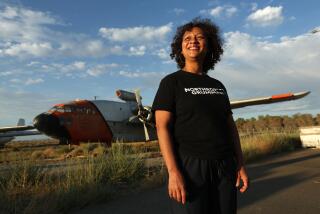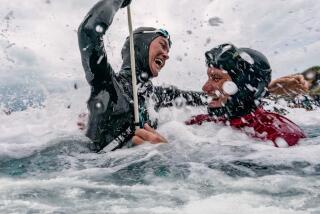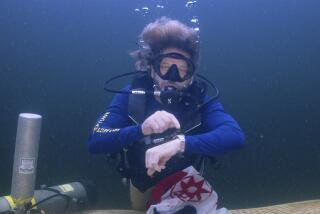Happily Over Their Heads
- Share via
More time is spent in the water than in the classroom at the College of Oceaneering, but replace any notion of drifting in aquamarine seas with the reality of jumping into claustrophobic tanks and groping through the brown muck that edges Wilmington Harbor.
About 250 students a year do not consider that punishment, paying nearly $14,000 to learn the seafaring equivalent of construction work: underwater inspection, underwater welding and water rescue.
The college’s admission criteria contain the first hints to its uniqueness. In addition to having a high school diploma, candidates must undergo a physical exam that includes tests for bad backs, ear problems, lung function and, yes, claustrophobia.
What’s missing from that list gives additional perspective: While preferred, neither swimming nor scuba certification is required. Those who complete the course and head to work underwater will be perpetually attached to a tether that brings them air to breathe and can be used to pull them up if they cannot propel themselves to the surface.
“Swimming isn’t necessary. You can get in the water with a life vest and a good pair of fins,” said diving instructor Tom Mix. “We’re just glorified construction workers.”
*
The largest market for graduates of the school is offshore oil and natural gas extraction jobs--pipe laying, pipe inspection and so on--in the Gulf of Mexico, where the pay is intended to compensate for impossibly long hours and grueling conditions.
Mix began his career there nearly three decades ago and progressed to its upper echelon before turning to teaching. He worked as the lead diver on the Suez Canal clearing project, traveled to Thailand on another job and even joined in a treasure hunt in the Philippines that turned up millions of dollars worth of gold and jewels.
While he shares those tales with students, he also cautions them that counting on such adventures is folly. Hard-hat divers more commonly remain in “the Gulf,” where they spend days and even weeks living on barges or submerged in steel chambers stationed hundreds of feet beneath the surface.
Students from around the world are attracted to the tidy campus straddling the freight train tracks, but the vast majority of them are Californians.
Their average age is 24 and they are, with a few exceptions, working-class men with military backgrounds. It is a school of tattoos and bare chests and back slaps, where scuba divers are dismissed as recreational “tube suckers” and where 80% of the students receive financial aid, most of it in the form of government loans.
This summer, among the College of Oceaneering’s enrollees are a United Parcel Service worker, a former hotel maintenance worker and roofer Steve Hinders, a U.S. Navy veteran who emerged weary and wet on a recent day after checking out some underwater equipment. When he reported that it was “a total mess--all piled on top of one another,” he was sent down again to straighten it out.
Only three women currently attend. Others are dissuaded by the hard physical nature of the work, the dozens of pull-ups required daily by the school and the prospect of encountering all-male crews on jobs after graduation.
“It’s a real guy thing,” said Lisa Benight, who worked as an accountant in Santa Rosa before she fell in love with scuba diving three years ago. “I’m not going to the Gulf of Mexico when I finish here.”
Like Benight, many of the students stumbled on the school after finding other jobs unfulfilling or looked to it as a way to forge a career from a scuba diving hobby. But a few sought out the college to realize lifelong dreams, knowing it is one of only three places on the West Coast that offer comparable training, the others being Santa Barbara City College and a private diving institute in Washington state.
“I had seen underwater welders on TV when I was about 9 years old and knew it was what I wanted to do,” said Reno machinist Lance Edwards, who at 36 is the oldest in the program this year.
Founded by a former U.S. Navy dive master and a diving contractor in 1969, the college ran into hard times a few years back, filing for bankruptcy and seeing its student loan default rate reach a dismal 29% in 1992. But it changed hands two years ago, when a retired adult school principal and a longtime corporate executive teamed up to buy its buildings and take over its waterfront leases, issued by the Los Angeles Harbor Department.
The new owners say it is now thriving financially, with a full student roster and improving loan default rate. They also know that their best selling point is the school’s job placement rate--company records show that 93% of the graduates got jobs last year. About half gained diving jobs, according to the records, while others applied their new skills to dry land or “topside” positions in building inspection, emergency medical service and mainstream construction.
The popular Gulf of Mexico jobs pay $8 an hour to start, but four hours of daily overtime are virtually guaranteed.
*
Curriculum is driven by the commercial diving industry and is often tailored to fit specific employer requests: An admission requirement for scuba certification was dropped after companies insisted they didn’t care about it; a crane was purchased to move heavy items into the water after companies said graduates lacked adequate rigging know-how.
President John Schwitters, the former corporate executive, proudly displays a letter from one of the five major employers, Houston-based S&J; Diving Inc., which congratulates the school on its receptiveness to suggestions.
“You teach kids and they find jobs,” he said. “It’s the best thing I’ve ever done.”
Students attend the school two days a week in 10 five-week cycles, the first cycle consisting of classroom instruction in subjects ranging from physiology to diving safety and the history of the oil industry. The next 10 weeks are dedicated to hands-on lessons, such as rigging--using ropes and block and tackle--and how to run a hyperbaric chamber to counteract cramping and other symptoms of decompression sickness.
Then students get wet--first spending five weeks jumping into giant 8,000-gallon tanks, testing out different diving helmets and learning to rely on a breathing tube tended by fellow students standing nearby.
“It’s a pretty strong bond,” observed instructor Ray Senior as student Matt Nowlin dropped into the tank. “The guy in the water is trusting his life to the guy up here.”
The students are encouraged to become a fraternity of sorts, working together in the same team for months, as is common on the oil platforms, and even choosing a name, motto and flag. The current tank crew calls itself the “Bad Monkeys,” which Nowlin, the former hotel maintenance worker, said was simply the only option they came up with that was not profane.
From the tanks, students move out to the diving platforms, where they spend time assembling and dismantling a labyrinth of pipes underwater, largely by touch. The entire group’s final examination mark hinges on putting the system together correctly despite the zero visibility, with one grade lost for every time they have to try again.
The last 20 weeks are spent specializing either in dive medicine, welding or inspection, in which students learn to locate holes and cracks in underwater pipes by using techniques such as underwater photography and ultrasonics.
The school issues certificates of completion unless students do additional academic work at a community college, which gains them an associate of science degree. School officials encourage the latter because it makes the students more marketable.
A less tangible factor in the college’s high placement rate is personal connections between employers and individual faculty members. In this arena, underwater welding instructor Duke Ogden is king, boasting that all of his graduates get jobs, usually leaving the night of graduation for the Gulf.
Ogden worked there for years after leaving the Navy, where he had served in its elite diving brigade and reenlisted during the Vietnam War because he wanted “another piece of it.”
*
His students learn to fuse and cut through metal underwater with torches that flame at temperatures up to 10,000 degrees. They also learn to put up with exacting standards and commands barked in what Ogden describes as his “rude and crude” style. A student caught floating casually in the water for mere seconds is immediately reprimanded.
“This is boot camp,” said Ogden, who wears a hard hat shaped like a cowboy hat. “They’ve got to get through me to get a job in the industry.”
While Ogden insists that being nasty comes naturally, he acknowledges that he lays it on thick for a reason: A tough management style is what graduates will most likely encounter from an employer in the gulf, a style he estimates sends two-thirds of new hires packing within three months.
“There’s no forgiveness in this business,” he said. “I want them to be more afraid of me than they are of the job. . . . I want these people to succeed.”
College of Oceaneering
* Location: 272 S. Fries Ave., Wilmington, Calif. 90744
* Phone: (310) 834-2501
* E-mail: https://www.diveco.com
* Annual enrollment: 250 students
* Job placement rate last year: 93%
* Placement in dive jobs: 53%
* Cost (tuition, books, fees): $13,950
More to Read
Sign up for Essential California
The most important California stories and recommendations in your inbox every morning.
You may occasionally receive promotional content from the Los Angeles Times.













